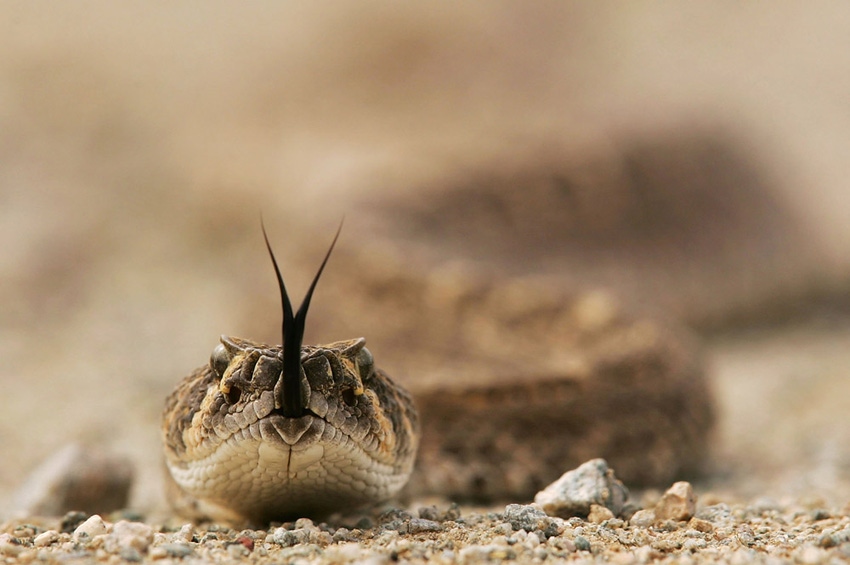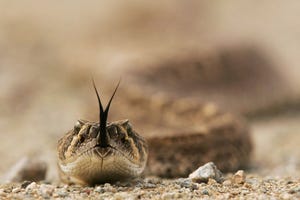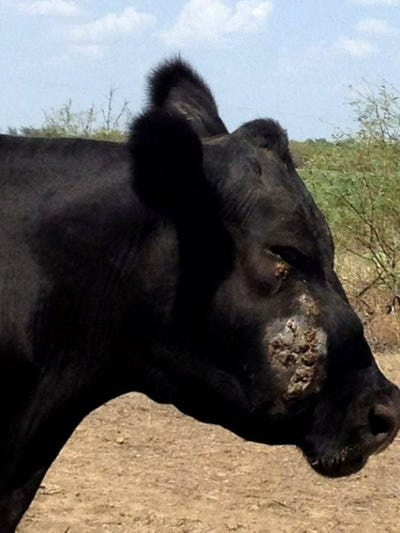How to treat, prevent snakebite in cattle and horses
The risk of snakebite in cattle, horses and dogs is ever-present.
June 22, 2016

In just about any place that cattle graze, venomous snakes slither and that means the chance for snakebite is ever-present. And anyone who has seen the after-effects in a snakebitten cow, horse or dog knows just how toxic the venom can be.
Rattlesnake venom contains two types of toxins—myotoxins and hemotoxins—according to Ginger Elliott, a veterinarian from Guthrie, Texas, who has seen many snakebitten animals. “The myotoxins create rapid swelling, pain and bleeding at the bite site and muscle necrosis, while the hemotoxins damage blood vessels, destroying red blood cells and hindering blood clotting. The damage is often relative to the size of the animal. Small rodents are immobilized by the toxins and die quickly, enabling the snake to eat them,” she explains.
The toxins (and amounts of each) can differ in various bites, and have different effects on the body. “Some rattlesnake venom contains more muscle toxins. Sometimes we see more swelling and lymph issues and more spread of the toxin systemically. Our western diamondbacks have venom containing mostly myotoxins,” explains Elliott.
“As a general rule, the prairie rattler has more hemotoxins and we see some swelling but perhaps less tissue destruction. When toxins enter the bloodstream and lymph tissues, they can spread systemically. But many types of venom have several toxic components and consequently there are some unusual cases,” she says.
The higher up the leg, such as near armpit or groin, the worse it might be, says Jacques Fuselier, a veterinarian with the Whittington Veterinary Clinic, Abbeville, La. “The toxins can get into the bloodstream quicker. We worry about that with some bites, because there’s more risk for anaphylactic shock. The toxins may rupture red blood cells, which could lead to organ failure, starting with the kidneys,” he says.

Rattlesnakes are found almost anywhere cattle graze and that means, while rare, there’s always a risk of snakebite. Photo Credit: Getty Images
“We try to keep the toxin isolated and minimize its spread. If you can get the animal into a pen where it won’t be moving around, this helps. Decreasing activity can slow down spread of the toxin, just from decrease in blood flow. A big dose of rattlesnake venom presents risk of it getting systemic and causing organ failure after it gets into the bloodstream,” says Fuselier.
“Every animal responds differently to the toxins. The toxin is a foreign protein, so some individuals will have an allergic-type reaction. In some animals, the toxins spread rapidly within the body, and in others they won’t. It’s not common to have two cases that are identical,” says Fuselier.
Usually the toxins don’t have as much negative long-term effects on large animals like adult cattle but could have more serious consequences for a small animal or young calf, according to Rob Callan, head of livestock veterinary services at the Veterinary Teaching Hospital at Colorado State University. “The toxins can sometimes be more problem for horses, affecting the heart. Toxins may cause irregular rhythm, or damage the heart [which can be fatal]. I have not seen that problem reported in cattle.”

“Most bites [in cattle] are on the lower legs, unless it’s a curious individual that approaches the snake to smell it.†Rob Callan
Tissue damage at the bite site may be severe enough to result in necrotic areas that slough away. “I don’t know why some bites have a tremendous amount of necrosis and others do not,” says Glennon Mays, a veterinarian with Texas A&M University. “I’ve read that all snakebites do not necessarily inject venom. In some cases maybe the snake is striking defensively, saying ‘leave me alone,’ and saving venom for killing prey,” he says. There is also the possibility that some bites might contain less venom if the snake had recently bitten and killed prey, temporarily depleting its venom supply.
Then there’s the possibility that it’s not snakebite at all. Mays says that often a suspected snakebite turns out to be something else. Swelling on a lower leg, for instance, is more often due to foot rot or another infection rather than snakebite.
“Animal owners over the years have asked me to look at lumps on jaws, faces, necks and other body parts, swollen legs and feet, believing their animal has suffered snakebite. Snakebite wounds have a fairly typical appearance and often some bleeding. Signs vary, depending on the length of time transpired since the bite occurred, the environmental temperature, the amount [dose] of venom and other factors that might affect the appearance of the affected area,” he says.
“Often a swelling that the owner is worried about turns out to be an abscess or seroma [collection of fluid] or reaction of body tissue, rather than snakebite. This is why it’s important to have a proper diagnosis and involve your veterinarian.”
You might also like:
9 new pickups for the ranch in 2016
Use cow-pie-ology to monitor your herds nutritional status
70 photos of hardworking beef producers
5 must-do steps for fly control on cattle
Photo Tour: World's largest vertically integrated cattle operation
When is the best time to wean? It might be younger than you think
You won't believe this is the least expensive way to breed cows
You May Also Like


.png?width=300&auto=webp&quality=80&disable=upscale)
